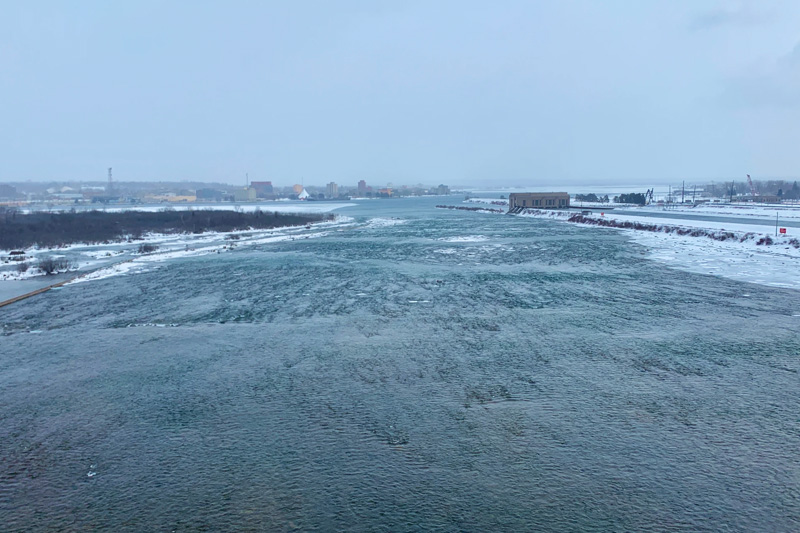Water Protectors
The year is 1850. A group of women and men are alongside the St. Marys River for a water ceremony. They are singing Anishinaabe songs matched to the pulsing of hand drums. The fast pace is full of energy, almost cheery, yet all of the singers have a serious tone and their eyes gaze forward with purpose. Everyone looks towards the centre of the circle where cotton blankets are occupied by two elders. On the West side, the youngest and most resilient of the group stand with their backs blocking the wind from the rest of the group. Their bare hands grip flag poles cut from fallen boughs and their knuckles strain against the wind pulling their flags tight above the circle. I imagine it pulls heat from their fingers just as quickly. A copper pail sits in the middle, closest to the elders and it is rippled by the wind. The edges are beginning to freeze. Similarly, the government of Canada is in turmoil over how to handle relations with the original people and the original people’s land. In this circle people have gathered from as far as Petoskey, Batchawana, and Missasauga for the water. They have come together on their shared value of the land. The year is actually 2020 and I am one of the people standing in the circle. Sure, there has been many changes over time, but the spirit of local environmentalism has persisted.
I am a guest to this ceremony, attending in my support of my friends’ activism. The Baawating Water Protectors have set up a peaceful protest at the foot of the bridge that spans the rapids that give Sault Ste Marie or Baawating its name. They have set up a blockade in support of the Wet’suwet’en resistance to governmental colonial pressures, corporate greed, and environmental degradation. It is a faraway place, but as I talk with folks at the blockade, it is apparent that similar pressures are felt here. People here feel a strong responsibility to the land. It is important to note that their narrative is one that takes place in the present. They are land protectors and their ability to handle hardships in the name of land and water isn’t awful, it leaves you full of awe. And it is lawful. Their resilience was on full display Thursday afternoon. Some folks were foregoing many basic human comforts to be an advocate. They are sleeping in tents, dealing with extreme weather, and handling racism laced threats.
Being a part of the water ceremony didn’t feel like I was part of a protest or being an activist. I suppose you can be the judge of that though. I do know I was frozen. I was in the midst of a sinus cold and even though I was bundled in three layers, the 60 km/hr wind gusts sucked the heat from me. I had wool long johns, thick socks, wool base layer, down jacket, and a wool jacket with all of my hoods drawn tight over my toque. I was glad to be moving as our group of around 80 began walking to the mid-point of the bridge. People began bunching up as we walked to stay warm. I noticed that the majority of people were not dressed as warmly as I was, yet I didn’t hear any complaints or looks of discomfort. We fell into a rhythm of the coordinated beating of hand drums that surrounded the group. With my clogged sinuses and three layers, I was confusing the pulsing of the drums with the pulsing of my carotid artery vibrating my inner ear.
I did not expect walking on the bridge to be that exciting having driven over countless times. Yet, this time I was walking, looking, and present for the water. Walking near the edge gave me the clearest view of the river I had ever had. Looking straight down, I could see the crisscross crimson sandstone bedding below the deep cold blue Lake Superior freshwater. I started thinking about how significant the river is and has been. At all the configurations and routes it carved over time. The empty bridge seemed like a historic moment. At this height it became clear how expansive the river really is. Below, the river drops over 7 metres in height and 2.2 million litres flow by every second. The water originates from the largest expanse of freshwater on the planet. As I freeze for my friends in their fight to protect their rights and promote water protection, the water below me takes on a greater meaning. I cannot explain it any other way. I started looking at the river differently. When I flicked on my tap the next morning, I felt thankful to have water and thankful to live in this place.

